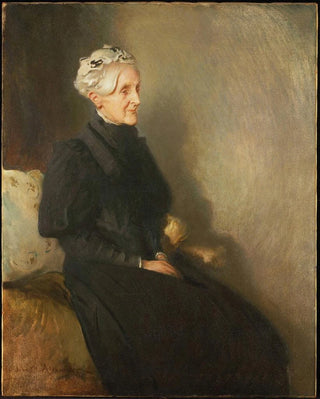Art print | Isabella Guthrie McCosh 1817-1909 - John White Alexander


View from behind

Frame (optional)
In the vast panorama of art history, certain works stand out for their ability to capture the very essence of their subject. The art print Isabella Guthrie McCosh 1817-1909, created by John White Alexander, is one of these remarkable pieces. This portrait, which evokes both intimacy and dignity, immerses us in the universe of the late 19th century, a time when portrait painting was undergoing a profound transformation. Through this work, the artist manages to transcend mere visual reproduction to offer a true testimony of his model's personality. Far from being a simple exercise in style, this painting becomes a mirror of the emotions and aspirations of its era, while bearing witness to Alexander's undeniable talent.
Style and uniqueness of the work
Alexander's style, often associated with the Symbolist movement, reveals itself in this piece through a subtle blend of realism and lyricism. The way he plays with light and shadow gives unprecedented depth to his subject, Isabella Guthrie McCosh. Every detail, from the drape of her dress to the delicate expression on her face, is meticulously crafted, demonstrating impressive technical mastery. The artist does not merely reproduce his model's features; he seeks to capture her essence, to convey an atmosphere that goes far beyond simple representation. The colors, both rich and nuanced, create a harmony that envelops the viewer, inviting them to immerse themselves in the inner universe of the painted woman. Thus, this portrait becomes a true ode to femininity, to the strength and vulnerability that coexist within each of us.
The artist and his influence
John White Alexander, an emblematic figure of the American art scene, knew how to mark his era with his innovative approach to portraiture. Influenced by the great European masters, he developed a style that is uniquely his own, combining tradition and modernity. His work, rich in emotion and subtlety, has inspired many contemporary artists and paved the way for a new understanding of the art print. By focusing on the psychology of his models, Alexander succeeded in giving a voice

Matte finish

View from behind

Frame (optional)
In the vast panorama of art history, certain works stand out for their ability to capture the very essence of their subject. The art print Isabella Guthrie McCosh 1817-1909, created by John White Alexander, is one of these remarkable pieces. This portrait, which evokes both intimacy and dignity, immerses us in the universe of the late 19th century, a time when portrait painting was undergoing a profound transformation. Through this work, the artist manages to transcend mere visual reproduction to offer a true testimony of his model's personality. Far from being a simple exercise in style, this painting becomes a mirror of the emotions and aspirations of its era, while bearing witness to Alexander's undeniable talent.
Style and uniqueness of the work
Alexander's style, often associated with the Symbolist movement, reveals itself in this piece through a subtle blend of realism and lyricism. The way he plays with light and shadow gives unprecedented depth to his subject, Isabella Guthrie McCosh. Every detail, from the drape of her dress to the delicate expression on her face, is meticulously crafted, demonstrating impressive technical mastery. The artist does not merely reproduce his model's features; he seeks to capture her essence, to convey an atmosphere that goes far beyond simple representation. The colors, both rich and nuanced, create a harmony that envelops the viewer, inviting them to immerse themselves in the inner universe of the painted woman. Thus, this portrait becomes a true ode to femininity, to the strength and vulnerability that coexist within each of us.
The artist and his influence
John White Alexander, an emblematic figure of the American art scene, knew how to mark his era with his innovative approach to portraiture. Influenced by the great European masters, he developed a style that is uniquely his own, combining tradition and modernity. His work, rich in emotion and subtlety, has inspired many contemporary artists and paved the way for a new understanding of the art print. By focusing on the psychology of his models, Alexander succeeded in giving a voice






